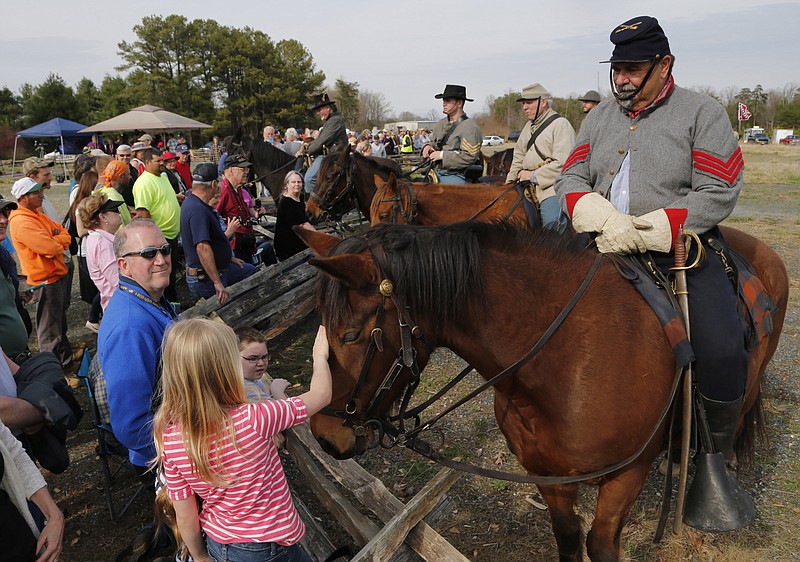APPOMATTOX, Va. (AP) - The surrender of Confederate Robert E. Lee to Union Lt. Gen. Ulysses S. Grant 150 years ago Thursday was the definitive milestone of the end of the Civil War. This is a rolling account of Thursday's commemoration of the anniversary, including a reenactment of Lee's last clash with Grant's troops and the Confederate surrender in a Virginia farmhouse. Interspersed are historical accounts of events 150 years ago:
___
2015:
Ahead of the battle reenactment, the boys of the Confederate 11th Virginia were a seemingly pretty cool bunch as those portraying Union troops gathered several fields away at Appomattox Court House amid these rolling farm fields of neat brick buildings and white picket fences.
But a stoic Chris Ferree couldn't contain his excitement when asked about his role in the 150th commemoration of Lee's surrender here, effectively ending the Civil War 150 years ago on Thursday.
"This is an awesome place to be," Ferree, of Roanoke, said. "We're all excited to be here."
The Confederate re-enactors were a ragtag, mismatched group of heavy wool coats, ill-fitting trousers and more types of hats than a haberdashery. Dozens stood along a rough wooden fence, their muskets stacked at the ready.
The Union and Southern re-enactors spent the night encamped in tents at Appomattox Court House National Historical Park.
___
2015:
The smell of wood smoke greeted the first of thousands of visitors expected to flock to the park for several days of commemorative events. The outline of Union troops in formation could be seen in fields as visitors approached the park.
Perry Miller of Salisbury, a re-enactor with the North Carolina 28th from Salisbury, explained the strategy succinctly: "We're trying to break through the Union lines."
Thomas Holbrook, a park ranger on loan from Gettysburg to Appomattox, went down the line of re-enactors for a quick briefing before battle.
"This is part of what I like to call the armistice that was signed on April 9, when Gen. Lee surrendered the Army of Northern Virginia," he said.
___
1865:
The conflict to sputter out in the hours before Lee formally called it quits.
Ragged, hungry Southern soldiers, many straggling while on the run from federal forces, began giving up alone and in small bunches before the official surrender at a farmhouse in Appomattox Courthouse, Virginia. Days earlier in April 1865, the Union Army had smashed their way into the Confederate capital of Richmond, Virginia.
Lee's forces, seeking an escape route, had crossed the Appomattox River while burning bridges, AP reported 150 years ago this week. Union forces "attacked them vigorously" in the hours before the official surrender, convincing Lee the fight was over. AP reporting from 150 years ago cited accounts as saying "the road for miles was strewn with broken down wagons, caissons, and baggage of all kinds, presenting a scene seldom witnessed on the part of Lee's army."
